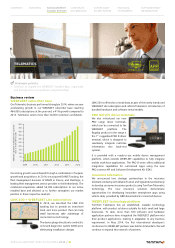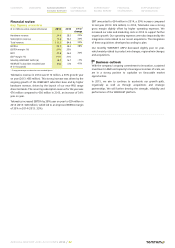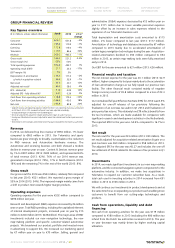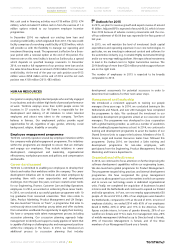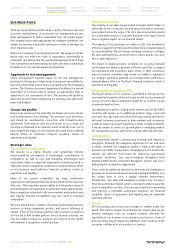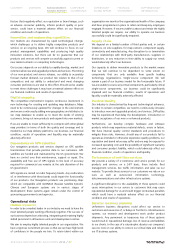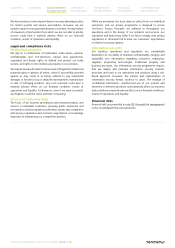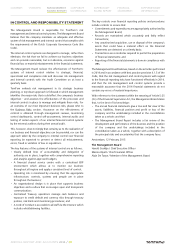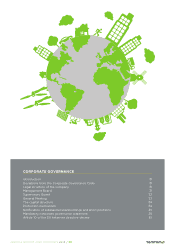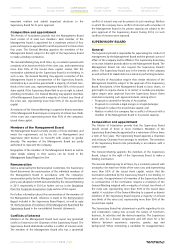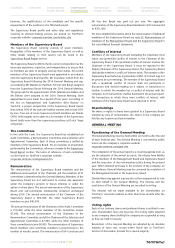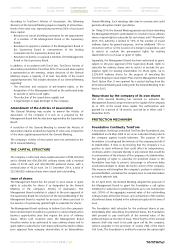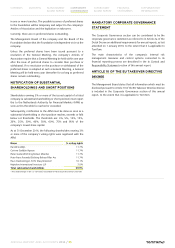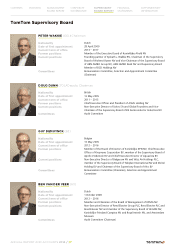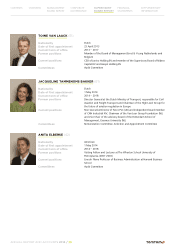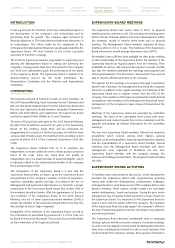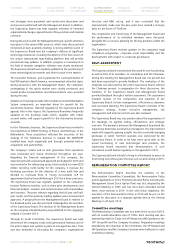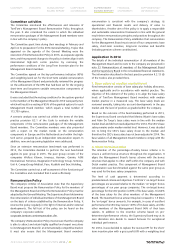TomTom 2014 Annual Report Download - page 31
Download and view the complete annual report
Please find page 31 of the 2014 TomTom annual report below. You can navigate through the pages in the report by either clicking on the pages listed below, or by using the keyword search tool below to find specific information within the annual report.
INTRODUCTION
TomTom is committed to being transparent and accountable in the
way we do business. Our corporate governance structure supports
and contributes to fulfilling this commitment to all our stakeholders.
We monitor our corporate governance structure continuously, to
ensure compliance with Dutch legislation, the Dutch Corporate
Governance Code (the Code), the company's Articles of
Association, applicable securities laws, and the rules and
regulations of NYSE Euronext Amsterdam, complemented by
several internal policies and procedures.
In this section, TomTom addresses its overall corporate governance
structure and compliance with the best practice provisions of the
Code. Occasional deviations from the Code are explained and
information is provided on the reasons for doing so.
Furthermore, any substantial changes in the corporate governance
structure of TomTom and its compliance with the Code will be
explained to the shareholders at a General Meeting.
DEVIATIONS FROM THE CORPORATE
GOVERNANCE CODE
As a Dutch listed company, TomTom is subject to the Code. The
Management Board and Supervisory Board are committed to
complying with the best practice provisions of the Code and will
continue to do so.
TomTom complies with all of the relevant provisions of the Code,
with the exception of the following provisions: II.2.4 and IV.1.1.
The reasons for these deviations are explained below.
Provision II.2.4
Best practice provision II.2.4 provides that if options are granted,
they shall, in any event, not be exercised in the first three years
after the date of granting. The number of options to be granted
shall be dependent on the achievement of challenging targets
specified beforehand.
At the 2014 General Meeting, the proposal to amend the
remuneration policy with regard to the long-term incentive
component laid down in the TomTom NV Management Board
Stock Option Plan (the Plan) was adopted. As a result of this
decision, the performance conditions for the vesting of the options
were removed. All options granted under the Plan shall be granted
conditional to continued employment of the members of the
Management Board only. TomTom deviates from best practice
provision II.2.4 to the extent that it does not specify targets
beforehand. A vesting period of three years remains applicable.
The reason for amending the remuneration policy was to align it
better with international high-tech sector practice. Under the new
plan, the Management Board remains continuously focused on
creating more value for its shareholders.
TomTom's comparator companies are international companies in
the high-tech sector. These companies continue to favour stock
option plans and operate in environments not subject to the Code.
The current Plan is reflective of competitive practices and enables
TomTom to be competitive for international senior leadership
talent.
Furthermore, the inclusion of vesting conditions in addition to the
increase of TomTom's share price of the options results in multiple
layers of hurdles for the Management Board to potentially obtain
value. Stock options carry an innate de facto performance condition
that focuses on achieving stock price growth before value can be
derived from stock option grants. The value of the stock option
remains wholly dependent on the development of the company's
stock price.
This new remuneration policy is deemed to be appropriate for the
company at this time.
Provision IV.1.1
Best practice provision IV.1.1 provides that the General Meeting
may pass a resolution to cancel the binding nature of a nomination
for the appointment of a member of the Management Board or
the Supervisory Board and/or a resolution to dismiss a member of
the Management Board or of the Supervisory Board by an absolute
majority of the votes cast. It may be provided that this majority
should represent a given proportion of the issued capital, which
proportion may not exceed one-third.
TomTom's Articles of Association provide that a binding
nomination for the appointment of members of the Management
Board or of the Supervisory Board may only be set aside by a
resolution of the General Meeting passed with a two-thirds majority
representing more than 50% of its issued share capital. The same
provision applies to any resolution to dismiss a member of the
Management Board or of the Supervisory Board.
The company deviates from the best practice provision outlined in
the preceding paragraph because it believes that maintaining
continuity in its Management Board and Supervisory Board is critical
for delivering long-term shareholder value. The company would like
to protect its stakeholders against a sudden change in management
by maintaining the qualified majority and voting quorum
requirement, which is consistent with Dutch law.
LEGAL STRUCTURE OF THE COMPANY
TomTom NV is a public limited liability company established under
Dutch law and listed on NYSE Euronext Amsterdam in the
Netherlands. TomTom has a two-tier governance structure
consisting of a Management Board and a Supervisory Board.
MANAGEMENT BOARD
General
The Management Board is responsible for the day-to-day
management of the operations of the company. Its responsibilities
involve setting and achieving the company's strategic objectives,
managing the company's strategic risks, legal compliance and
corporate social responsibility matters insofar as these are relevant
to the company's business. In these areas the Management Board
is accountable to the Supervisory Board and to the General
Meeting. In performing its duties, the Management Board is guided
by the interests of the company, taking into consideration the
interests of the company's stakeholders as a whole. The
Management Board must provide the Supervisory Board with all
information necessary for the exercise of the duties of the
Supervisory Board in a timely manner. Furthermore, the
Management Board must consult with the Supervisory Board on
CONTENTS OVERVIEW MANAGEMENT
BOARD REPORT CORPORATE
GOVERNANCE SUPERVISORY
BOARD REPORT FINANCIAL
STATEMENTS SUPPLEMENTARY
INFORMATION
ANNUAL REPORT AND ACCOUNTS 2014 / 31


